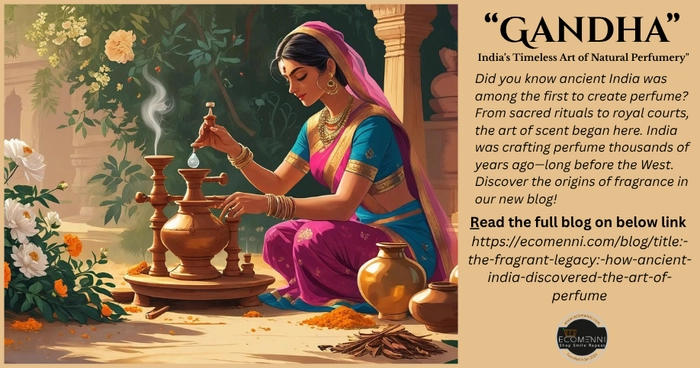Introduction
Long before perfume graced the shelves of modern department stores, ancient India was already enveloped in the art of fragrance. Perfume, or gandha as it was called in Sanskrit, wasn’t just a luxury—it was a way of life. The roots of perfumery trace deeply into the cultural, medicinal, and spiritual soil of India, making it one of the earliest civilizations to harness the power of scent.
The Origins: Perfume in the Vedic Age
The use of aromatic substances in India dates back over 5,000 years to the Indus Valley Civilization (circa 3300–1300 BCE). Archaeological discoveries in sites like Mohenjo-daro and Harappa have unearthed distillation apparatuses that may have been used for extracting essential oils—a technique later perfected in Ayurvedic practices.
Texts like the Rigveda and Atharvaveda mention fragrant substances like sandalwood, camphor, saffron, agarwood (oud), and various resins and flowers. These ingredients were burned, infused in oils, or worn as pastes to honor deities, enhance meditation, or simply provide comfort.
Perfume in Ayurveda and Daily Life
Ayurveda, India’s ancient system of medicine, deeply integrated fragrance into its healing practices. Aromatic oils were used in massage (abhyanga), incense was burned to purify air and mind, and flower-scented waters were used for cleansing. Perfumes weren’t just cosmetic; they were therapeutic.
Royalty and nobility also made extensive use of perfumes. The legendary queens and kings of India, such as Rani Padmini and Emperor Ashoka, were known to anoint themselves with exotic attars—natural perfumes made by distilling flower petals with water or sandalwood oil.
The Art of Attar-Making
India perfected the method of attar (also called ittar) production, especially during the Mughal era. Although this technique became more widespread under Persian influence, its foundations were laid in ancient Indian distillation. Kannauj, a city in northern India, remains the perfume capital of India to this day—producing traditional attars using methods that have hardly changed in centuries.
Attars made from rose, jasmine, vetiver (known as khus), and even monsoon rain (mitti attar) were considered sacred and sensuous. The process involved simmering petals over a low flame and condensing their essence into sandalwood oil—a delicate, time-intensive art that exemplified India's mastery of natural perfumery.
Spiritual Significance
Perfume wasn’t merely decorative—it had deep spiritual value. Temples were infused with incense; gods were adorned with scented oils; and rituals included aromatic offerings. Fragrance was believed to elevate the soul, balance the doshas (body energies), and create a divine atmosphere.
Legacy and Global Influence
Indian perfumery left a mark on the world. Traders on the Silk Road and spice routes carried Indian aromatics to the Middle East, Egypt, and Europe. Many of today’s most prized ingredients in perfumery—like sandalwood and vetiver—have Indian origins.
Even today, the natural perfumes of India offer a soulful alternative to synthetic scents, connecting wearers to a timeless tradition rooted in nature and spirit.
Conclusion
The story of perfume doesn't begin in a French laboratory—it begins in the sacred temples, royal courts, and herbal kitchens of ancient India. It is a fragrant legacy that continues to inspire, reminding us that scent is not just something we wear—it's something we experience with body, mind, and soul.

